Detailed Report on the Taxation of Australian Superannuation
VerifiedAdded on 2023/01/16
|13
|3212
|215
Report
AI Summary
This report provides a comprehensive overview of the taxation of superannuation in Australia, focusing on the guidelines outlined in Division 295-1 of the ITAA 1997. It examines the application of tax on superannuation entities and complying funds, detailing the process of calculating taxable income and the components thereof. The report highlights modifications related to complying superannuation funds, including capital gains tax and the inclusion of contributions in assessable income. It explores deductions for contributions, investments in Pooled Super Trusts (PST), and life policies. Furthermore, it discusses personal contributions, roll-over amounts, transfers from foreign funds, and contributions not subject to tax. The report also covers exempted income, No-TFN contribution income, and capital gains, providing a detailed analysis of each aspect. It emphasizes the importance of Division 295 in streamlining the taxation process and ensuring accurate tax rates for superannuation entities.

Running head: TAXATION OF SUPERANNUATION
Taxation of Superannuation
Name of the Student
Name of the University
Authors Note
Course ID
Taxation of Superannuation
Name of the Student
Name of the University
Authors Note
Course ID
Paraphrase This Document
Need a fresh take? Get an instant paraphrase of this document with our AI Paraphraser
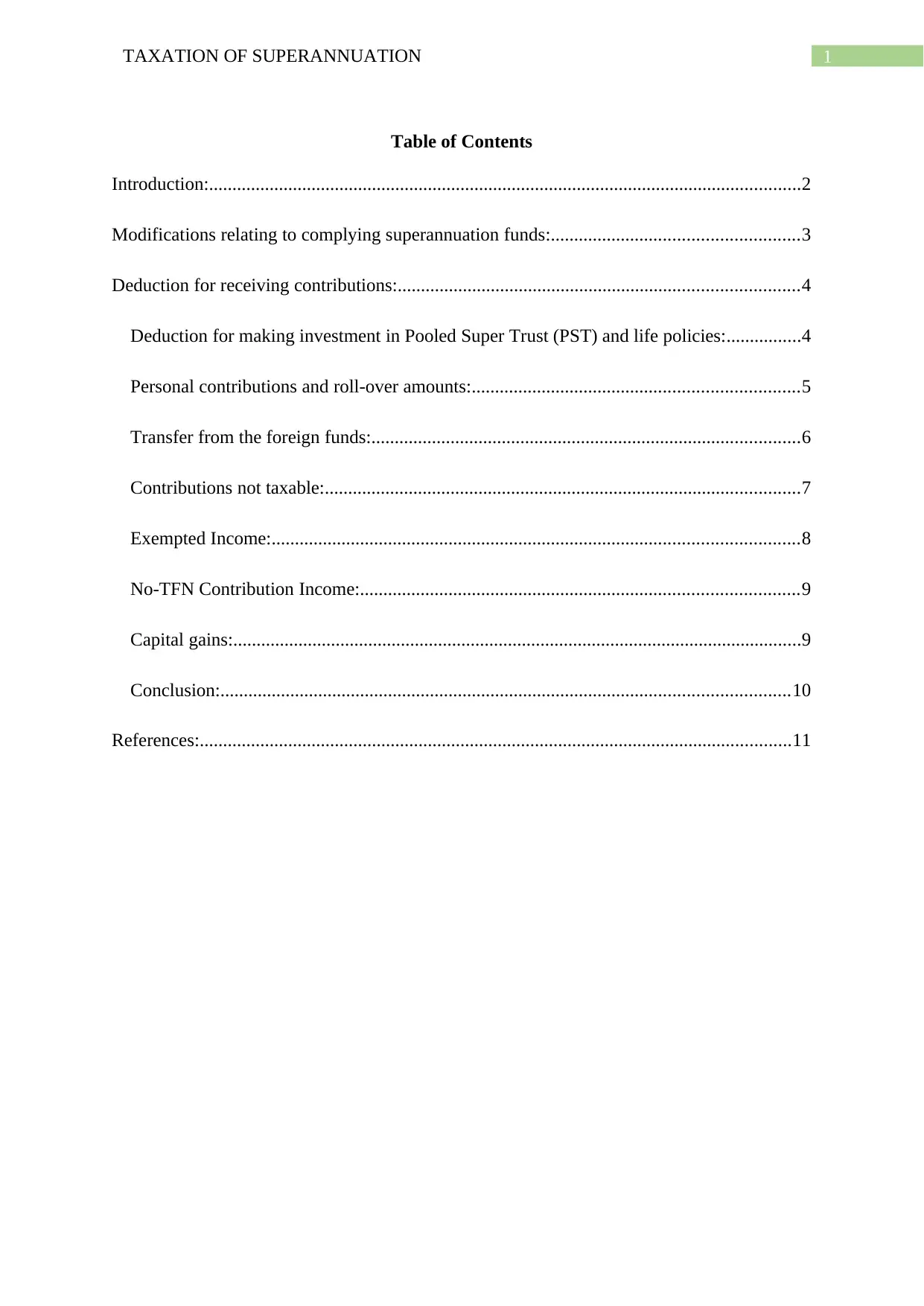
1TAXATION OF SUPERANNUATION
Table of Contents
Introduction:...............................................................................................................................2
Modifications relating to complying superannuation funds:.....................................................3
Deduction for receiving contributions:......................................................................................4
Deduction for making investment in Pooled Super Trust (PST) and life policies:................4
Personal contributions and roll-over amounts:......................................................................5
Transfer from the foreign funds:............................................................................................6
Contributions not taxable:......................................................................................................7
Exempted Income:.................................................................................................................8
No-TFN Contribution Income:..............................................................................................9
Capital gains:..........................................................................................................................9
Conclusion:..........................................................................................................................10
References:...............................................................................................................................11
Table of Contents
Introduction:...............................................................................................................................2
Modifications relating to complying superannuation funds:.....................................................3
Deduction for receiving contributions:......................................................................................4
Deduction for making investment in Pooled Super Trust (PST) and life policies:................4
Personal contributions and roll-over amounts:......................................................................5
Transfer from the foreign funds:............................................................................................6
Contributions not taxable:......................................................................................................7
Exempted Income:.................................................................................................................8
No-TFN Contribution Income:..............................................................................................9
Capital gains:..........................................................................................................................9
Conclusion:..........................................................................................................................10
References:...............................................................................................................................11
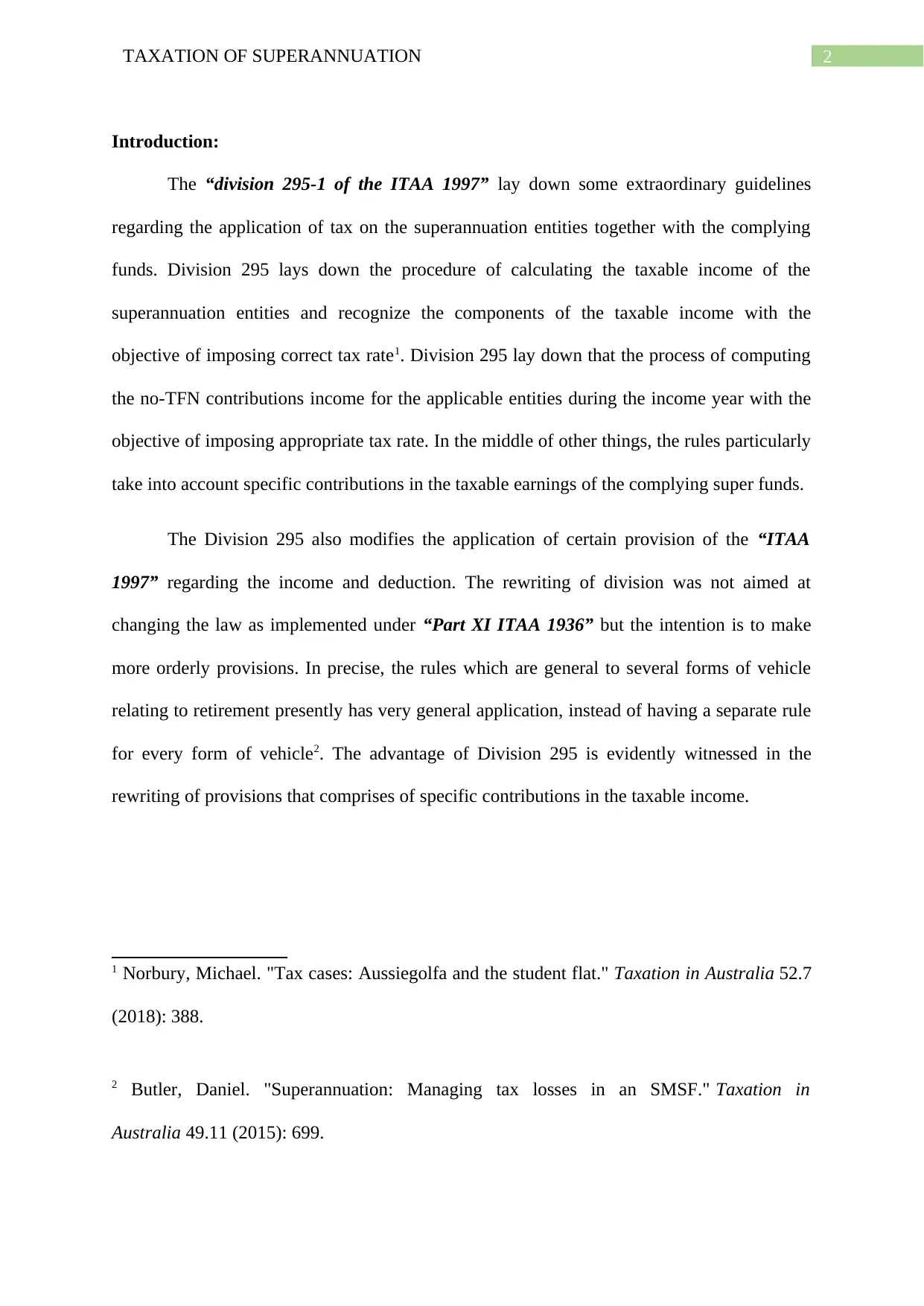
2TAXATION OF SUPERANNUATION
Introduction:
The “division 295-1 of the ITAA 1997” lay down some extraordinary guidelines
regarding the application of tax on the superannuation entities together with the complying
funds. Division 295 lays down the procedure of calculating the taxable income of the
superannuation entities and recognize the components of the taxable income with the
objective of imposing correct tax rate1. Division 295 lay down that the process of computing
the no-TFN contributions income for the applicable entities during the income year with the
objective of imposing appropriate tax rate. In the middle of other things, the rules particularly
take into account specific contributions in the taxable earnings of the complying super funds.
The Division 295 also modifies the application of certain provision of the “ITAA
1997” regarding the income and deduction. The rewriting of division was not aimed at
changing the law as implemented under “Part XI ITAA 1936” but the intention is to make
more orderly provisions. In precise, the rules which are general to several forms of vehicle
relating to retirement presently has very general application, instead of having a separate rule
for every form of vehicle2. The advantage of Division 295 is evidently witnessed in the
rewriting of provisions that comprises of specific contributions in the taxable income.
1 Norbury, Michael. "Tax cases: Aussiegolfa and the student flat." Taxation in Australia 52.7
(2018): 388.
2 Butler, Daniel. "Superannuation: Managing tax losses in an SMSF." Taxation in
Australia 49.11 (2015): 699.
Introduction:
The “division 295-1 of the ITAA 1997” lay down some extraordinary guidelines
regarding the application of tax on the superannuation entities together with the complying
funds. Division 295 lays down the procedure of calculating the taxable income of the
superannuation entities and recognize the components of the taxable income with the
objective of imposing correct tax rate1. Division 295 lay down that the process of computing
the no-TFN contributions income for the applicable entities during the income year with the
objective of imposing appropriate tax rate. In the middle of other things, the rules particularly
take into account specific contributions in the taxable earnings of the complying super funds.
The Division 295 also modifies the application of certain provision of the “ITAA
1997” regarding the income and deduction. The rewriting of division was not aimed at
changing the law as implemented under “Part XI ITAA 1936” but the intention is to make
more orderly provisions. In precise, the rules which are general to several forms of vehicle
relating to retirement presently has very general application, instead of having a separate rule
for every form of vehicle2. The advantage of Division 295 is evidently witnessed in the
rewriting of provisions that comprises of specific contributions in the taxable income.
1 Norbury, Michael. "Tax cases: Aussiegolfa and the student flat." Taxation in Australia 52.7
(2018): 388.
2 Butler, Daniel. "Superannuation: Managing tax losses in an SMSF." Taxation in
Australia 49.11 (2015): 699.
⊘ This is a preview!⊘
Do you want full access?
Subscribe today to unlock all pages.

Trusted by 1+ million students worldwide
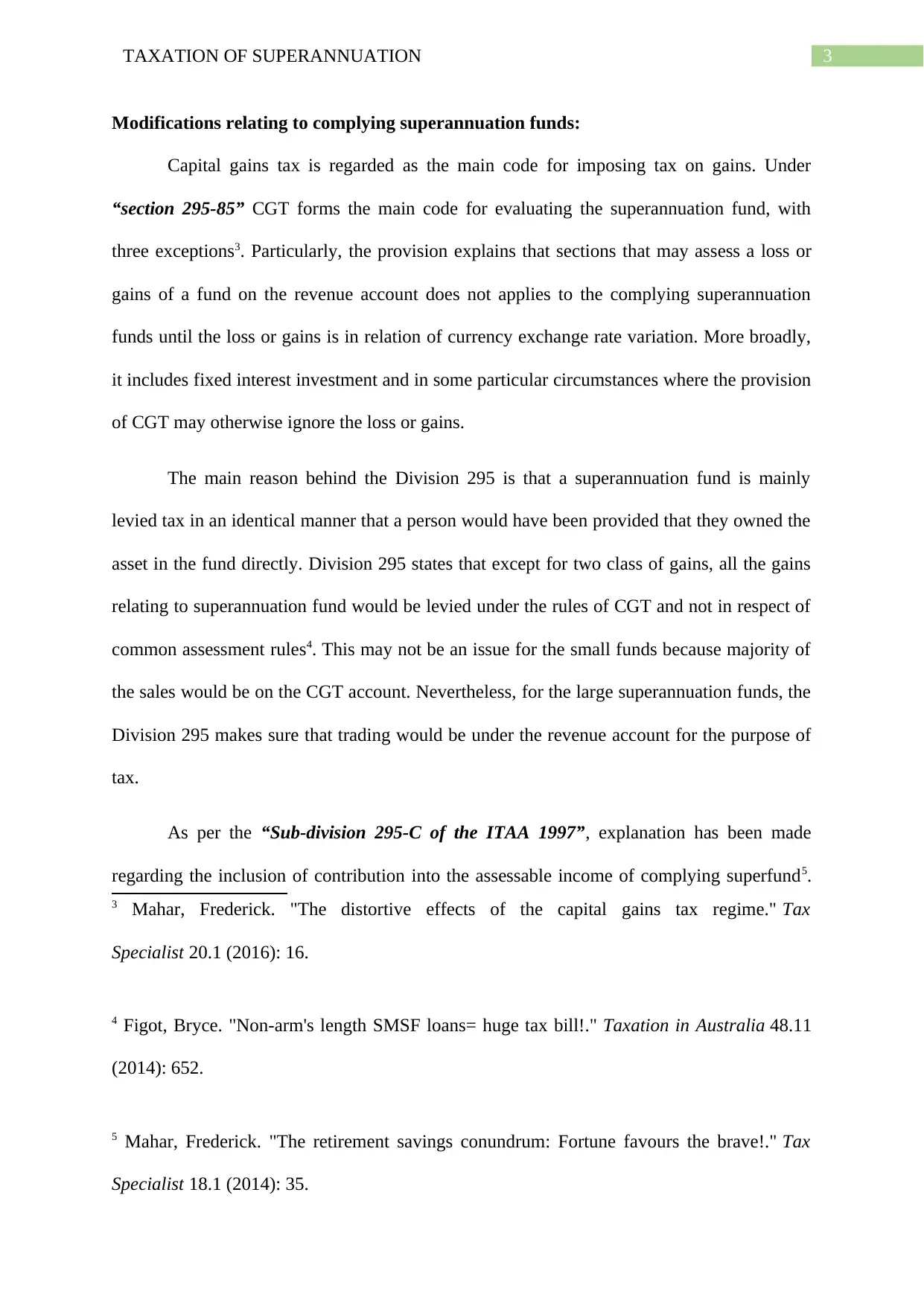
3TAXATION OF SUPERANNUATION
Modifications relating to complying superannuation funds:
Capital gains tax is regarded as the main code for imposing tax on gains. Under
“section 295-85” CGT forms the main code for evaluating the superannuation fund, with
three exceptions3. Particularly, the provision explains that sections that may assess a loss or
gains of a fund on the revenue account does not applies to the complying superannuation
funds until the loss or gains is in relation of currency exchange rate variation. More broadly,
it includes fixed interest investment and in some particular circumstances where the provision
of CGT may otherwise ignore the loss or gains.
The main reason behind the Division 295 is that a superannuation fund is mainly
levied tax in an identical manner that a person would have been provided that they owned the
asset in the fund directly. Division 295 states that except for two class of gains, all the gains
relating to superannuation fund would be levied under the rules of CGT and not in respect of
common assessment rules4. This may not be an issue for the small funds because majority of
the sales would be on the CGT account. Nevertheless, for the large superannuation funds, the
Division 295 makes sure that trading would be under the revenue account for the purpose of
tax.
As per the “Sub-division 295-C of the ITAA 1997”, explanation has been made
regarding the inclusion of contribution into the assessable income of complying superfund5.
3 Mahar, Frederick. "The distortive effects of the capital gains tax regime." Tax
Specialist 20.1 (2016): 16.
4 Figot, Bryce. "Non-arm's length SMSF loans= huge tax bill!." Taxation in Australia 48.11
(2014): 652.
5 Mahar, Frederick. "The retirement savings conundrum: Fortune favours the brave!." Tax
Specialist 18.1 (2014): 35.
Modifications relating to complying superannuation funds:
Capital gains tax is regarded as the main code for imposing tax on gains. Under
“section 295-85” CGT forms the main code for evaluating the superannuation fund, with
three exceptions3. Particularly, the provision explains that sections that may assess a loss or
gains of a fund on the revenue account does not applies to the complying superannuation
funds until the loss or gains is in relation of currency exchange rate variation. More broadly,
it includes fixed interest investment and in some particular circumstances where the provision
of CGT may otherwise ignore the loss or gains.
The main reason behind the Division 295 is that a superannuation fund is mainly
levied tax in an identical manner that a person would have been provided that they owned the
asset in the fund directly. Division 295 states that except for two class of gains, all the gains
relating to superannuation fund would be levied under the rules of CGT and not in respect of
common assessment rules4. This may not be an issue for the small funds because majority of
the sales would be on the CGT account. Nevertheless, for the large superannuation funds, the
Division 295 makes sure that trading would be under the revenue account for the purpose of
tax.
As per the “Sub-division 295-C of the ITAA 1997”, explanation has been made
regarding the inclusion of contribution into the assessable income of complying superfund5.
3 Mahar, Frederick. "The distortive effects of the capital gains tax regime." Tax
Specialist 20.1 (2016): 16.
4 Figot, Bryce. "Non-arm's length SMSF loans= huge tax bill!." Taxation in Australia 48.11
(2014): 652.
5 Mahar, Frederick. "The retirement savings conundrum: Fortune favours the brave!." Tax
Specialist 18.1 (2014): 35.
Paraphrase This Document
Need a fresh take? Get an instant paraphrase of this document with our AI Paraphraser
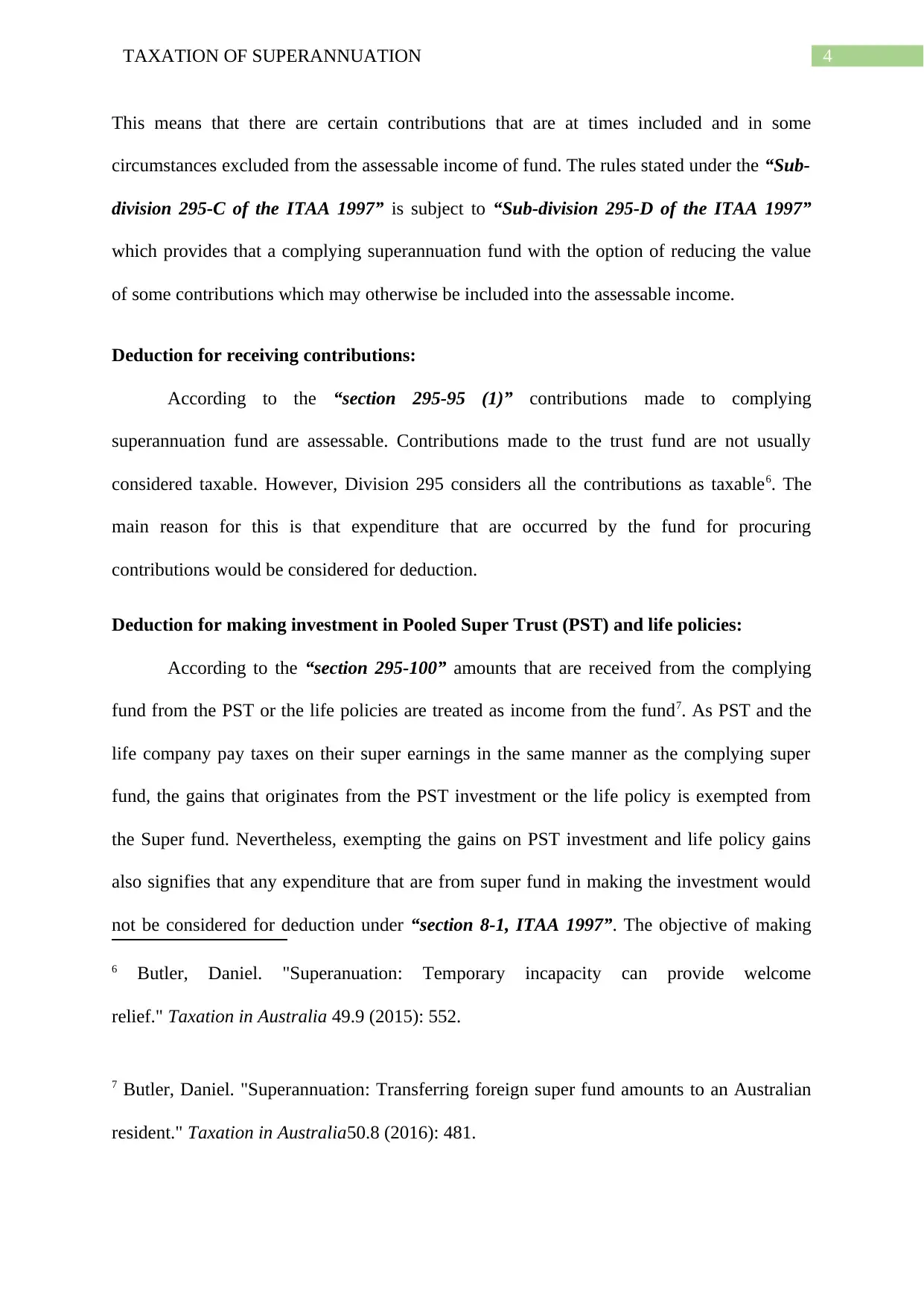
4TAXATION OF SUPERANNUATION
This means that there are certain contributions that are at times included and in some
circumstances excluded from the assessable income of fund. The rules stated under the “Sub-
division 295-C of the ITAA 1997” is subject to “Sub-division 295-D of the ITAA 1997”
which provides that a complying superannuation fund with the option of reducing the value
of some contributions which may otherwise be included into the assessable income.
Deduction for receiving contributions:
According to the “section 295-95 (1)” contributions made to complying
superannuation fund are assessable. Contributions made to the trust fund are not usually
considered taxable. However, Division 295 considers all the contributions as taxable6. The
main reason for this is that expenditure that are occurred by the fund for procuring
contributions would be considered for deduction.
Deduction for making investment in Pooled Super Trust (PST) and life policies:
According to the “section 295-100” amounts that are received from the complying
fund from the PST or the life policies are treated as income from the fund7. As PST and the
life company pay taxes on their super earnings in the same manner as the complying super
fund, the gains that originates from the PST investment or the life policy is exempted from
the Super fund. Nevertheless, exempting the gains on PST investment and life policy gains
also signifies that any expenditure that are from super fund in making the investment would
not be considered for deduction under “section 8-1, ITAA 1997”. The objective of making
6 Butler, Daniel. "Superanuation: Temporary incapacity can provide welcome
relief." Taxation in Australia 49.9 (2015): 552.
7 Butler, Daniel. "Superannuation: Transferring foreign super fund amounts to an Australian
resident." Taxation in Australia50.8 (2016): 481.
This means that there are certain contributions that are at times included and in some
circumstances excluded from the assessable income of fund. The rules stated under the “Sub-
division 295-C of the ITAA 1997” is subject to “Sub-division 295-D of the ITAA 1997”
which provides that a complying superannuation fund with the option of reducing the value
of some contributions which may otherwise be included into the assessable income.
Deduction for receiving contributions:
According to the “section 295-95 (1)” contributions made to complying
superannuation fund are assessable. Contributions made to the trust fund are not usually
considered taxable. However, Division 295 considers all the contributions as taxable6. The
main reason for this is that expenditure that are occurred by the fund for procuring
contributions would be considered for deduction.
Deduction for making investment in Pooled Super Trust (PST) and life policies:
According to the “section 295-100” amounts that are received from the complying
fund from the PST or the life policies are treated as income from the fund7. As PST and the
life company pay taxes on their super earnings in the same manner as the complying super
fund, the gains that originates from the PST investment or the life policy is exempted from
the Super fund. Nevertheless, exempting the gains on PST investment and life policy gains
also signifies that any expenditure that are from super fund in making the investment would
not be considered for deduction under “section 8-1, ITAA 1997”. The objective of making
6 Butler, Daniel. "Superanuation: Temporary incapacity can provide welcome
relief." Taxation in Australia 49.9 (2015): 552.
7 Butler, Daniel. "Superannuation: Transferring foreign super fund amounts to an Australian
resident." Taxation in Australia50.8 (2016): 481.

5TAXATION OF SUPERANNUATION
this rule is to permit the deduction for superannuation fund relating to outgoings occurred in
making investment in PST or policy. A PST is levied tax in the similar manner as the
superannuation fund, therefore any kind of gains made from the distribution should be tax
exempt in the hands of recipient of super fund. Therefore, this is the purpose of “section 295-
105”.
Personal contributions and roll-over amounts:
Personal contributions are considered taxable in relation to the complying
superannuation fund, however only up to the extent that the contributor has made claim for
tax deduction. The relation between the entitlement of contributors to the tax deduction and
the superannuation fund including the same as taxable income is through the notice that the
contributor has to give to fund so that they can be entitled to deduction for the contributions
made8. Furthermore, there are certain amounts that are rolled over from the superannuation
funds is also included as taxable income. The modification under the Division 295 states that
rolled over benefits from superannuation fund that are not yet taxed will be considered
assessable. A rollover from the fund of public sector up to a maximum amount can be taken
from those funds inside the tax concession is considered taxable to the receiving fund.
The modification also includes that under “section 295-190” the taxable component
of the directed termination payment is considered taxable to the fund9. Generally, these
amounts are considered payments that are made directly by the employers however under the
8 Mahar, Frederick. "Superannuation: Do contribution caps have any meaning?." Tax
Specialist 18.4 (2015): 180.
9 Williams, Raewyn. "Managing superannuation fund investment taxes." Taxation in
Australia 53.2 (2018): 77.
this rule is to permit the deduction for superannuation fund relating to outgoings occurred in
making investment in PST or policy. A PST is levied tax in the similar manner as the
superannuation fund, therefore any kind of gains made from the distribution should be tax
exempt in the hands of recipient of super fund. Therefore, this is the purpose of “section 295-
105”.
Personal contributions and roll-over amounts:
Personal contributions are considered taxable in relation to the complying
superannuation fund, however only up to the extent that the contributor has made claim for
tax deduction. The relation between the entitlement of contributors to the tax deduction and
the superannuation fund including the same as taxable income is through the notice that the
contributor has to give to fund so that they can be entitled to deduction for the contributions
made8. Furthermore, there are certain amounts that are rolled over from the superannuation
funds is also included as taxable income. The modification under the Division 295 states that
rolled over benefits from superannuation fund that are not yet taxed will be considered
assessable. A rollover from the fund of public sector up to a maximum amount can be taken
from those funds inside the tax concession is considered taxable to the receiving fund.
The modification also includes that under “section 295-190” the taxable component
of the directed termination payment is considered taxable to the fund9. Generally, these
amounts are considered payments that are made directly by the employers however under the
8 Mahar, Frederick. "Superannuation: Do contribution caps have any meaning?." Tax
Specialist 18.4 (2015): 180.
9 Williams, Raewyn. "Managing superannuation fund investment taxes." Taxation in
Australia 53.2 (2018): 77.
⊘ This is a preview!⊘
Do you want full access?
Subscribe today to unlock all pages.

Trusted by 1+ million students worldwide
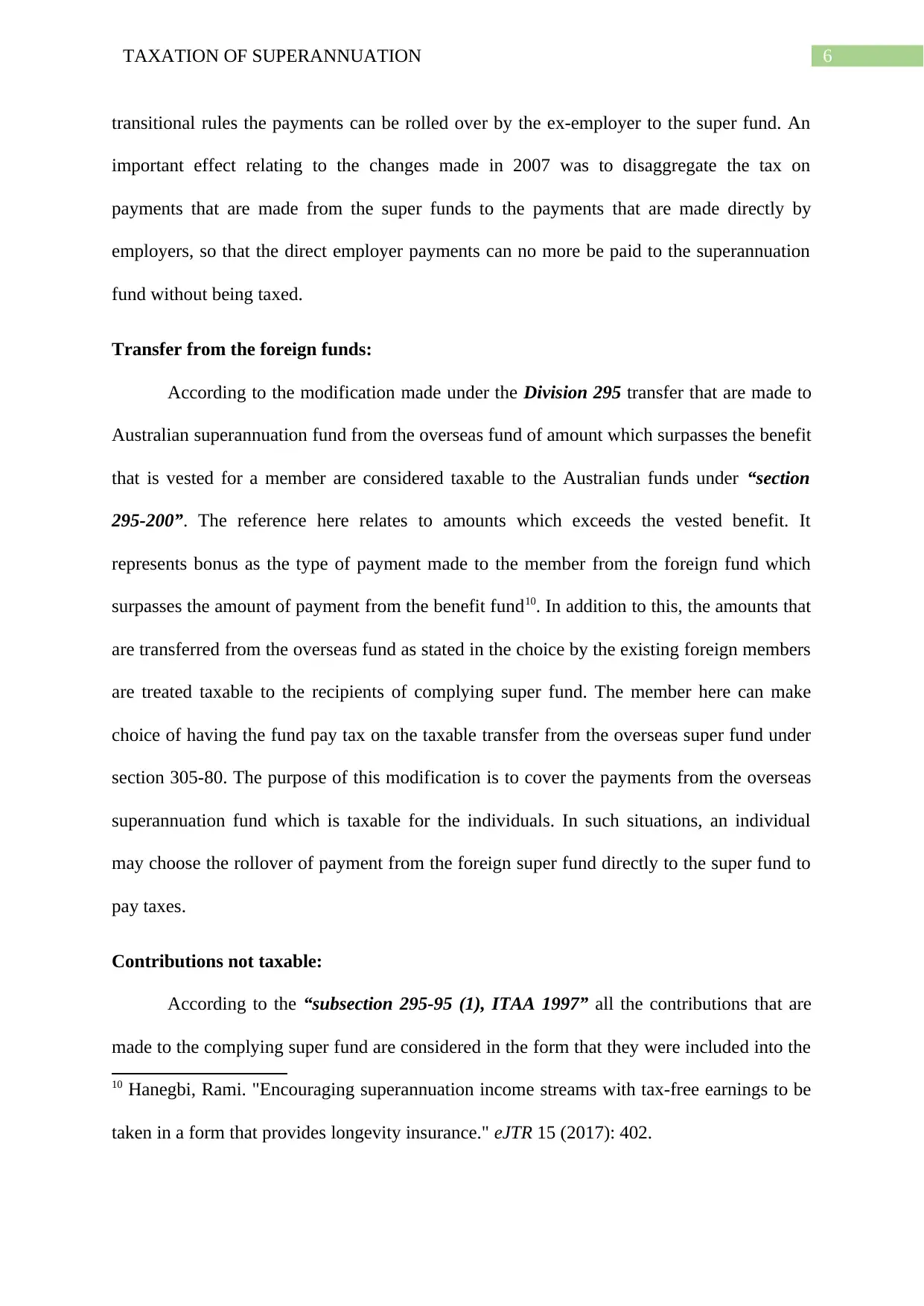
6TAXATION OF SUPERANNUATION
transitional rules the payments can be rolled over by the ex-employer to the super fund. An
important effect relating to the changes made in 2007 was to disaggregate the tax on
payments that are made from the super funds to the payments that are made directly by
employers, so that the direct employer payments can no more be paid to the superannuation
fund without being taxed.
Transfer from the foreign funds:
According to the modification made under the Division 295 transfer that are made to
Australian superannuation fund from the overseas fund of amount which surpasses the benefit
that is vested for a member are considered taxable to the Australian funds under “section
295-200”. The reference here relates to amounts which exceeds the vested benefit. It
represents bonus as the type of payment made to the member from the foreign fund which
surpasses the amount of payment from the benefit fund10. In addition to this, the amounts that
are transferred from the overseas fund as stated in the choice by the existing foreign members
are treated taxable to the recipients of complying super fund. The member here can make
choice of having the fund pay tax on the taxable transfer from the overseas super fund under
section 305-80. The purpose of this modification is to cover the payments from the overseas
superannuation fund which is taxable for the individuals. In such situations, an individual
may choose the rollover of payment from the foreign super fund directly to the super fund to
pay taxes.
Contributions not taxable:
According to the “subsection 295-95 (1), ITAA 1997” all the contributions that are
made to the complying super fund are considered in the form that they were included into the
10 Hanegbi, Rami. "Encouraging superannuation income streams with tax-free earnings to be
taken in a form that provides longevity insurance." eJTR 15 (2017): 402.
transitional rules the payments can be rolled over by the ex-employer to the super fund. An
important effect relating to the changes made in 2007 was to disaggregate the tax on
payments that are made from the super funds to the payments that are made directly by
employers, so that the direct employer payments can no more be paid to the superannuation
fund without being taxed.
Transfer from the foreign funds:
According to the modification made under the Division 295 transfer that are made to
Australian superannuation fund from the overseas fund of amount which surpasses the benefit
that is vested for a member are considered taxable to the Australian funds under “section
295-200”. The reference here relates to amounts which exceeds the vested benefit. It
represents bonus as the type of payment made to the member from the foreign fund which
surpasses the amount of payment from the benefit fund10. In addition to this, the amounts that
are transferred from the overseas fund as stated in the choice by the existing foreign members
are treated taxable to the recipients of complying super fund. The member here can make
choice of having the fund pay tax on the taxable transfer from the overseas super fund under
section 305-80. The purpose of this modification is to cover the payments from the overseas
superannuation fund which is taxable for the individuals. In such situations, an individual
may choose the rollover of payment from the foreign super fund directly to the super fund to
pay taxes.
Contributions not taxable:
According to the “subsection 295-95 (1), ITAA 1997” all the contributions that are
made to the complying super fund are considered in the form that they were included into the
10 Hanegbi, Rami. "Encouraging superannuation income streams with tax-free earnings to be
taken in a form that provides longevity insurance." eJTR 15 (2017): 402.
Paraphrase This Document
Need a fresh take? Get an instant paraphrase of this document with our AI Paraphraser

7TAXATION OF SUPERANNUATION
fund as the taxable income with the objective of working out the value of deduction11. As per
the subdivision 295-D funds are allowed to transfer their liability for contributions tax to the
life company which would later pay that liability12. This states that life companies in majority
of the cases holds the actual cash and assets for the super funds. As a result, super funds
would not be having any cash to pay their contributions tax obligation.
Division 295-D states that any kind of loss or outgoings that are directly occurred by
the fund in getting the contributions does not require any apportion under legislative
provision of “section 8-1, ITAA 1997” where it is occurred in getting both the taxable and
non-taxable contributions.
Exempted Income:
Under the “subdivision 295-F of the ITAA 1997”, the exempted income provision
forms the most important aspect in the taxation of super funds13. The modification is aimed at
attaining the design intent that pensions are only held for tax once and it should only at the
point of the recipient. Therefore, taxes on the earnings relating to the fund that supports the
pension requires exemption where taxes are levied on the pension benefit. The modified rules
11 Butler, Daniel. "Superannuation: SMSFs investing via unit trusts." Taxation in
Australia 50.6 (2015): 335.
12 Misic, Dragan. "New approach to capital raising: Tax perspective." Tax Specialist 21.2
(2017): 65.
13 Datt, Kalmen H., and Mark Keating. "The Commissioner’s obligation to make
compensating adjustments for income tax and GST in Australia and New
Zealand." Australian Tax Forum. Vol. 33. No. 3. 2018.
fund as the taxable income with the objective of working out the value of deduction11. As per
the subdivision 295-D funds are allowed to transfer their liability for contributions tax to the
life company which would later pay that liability12. This states that life companies in majority
of the cases holds the actual cash and assets for the super funds. As a result, super funds
would not be having any cash to pay their contributions tax obligation.
Division 295-D states that any kind of loss or outgoings that are directly occurred by
the fund in getting the contributions does not require any apportion under legislative
provision of “section 8-1, ITAA 1997” where it is occurred in getting both the taxable and
non-taxable contributions.
Exempted Income:
Under the “subdivision 295-F of the ITAA 1997”, the exempted income provision
forms the most important aspect in the taxation of super funds13. The modification is aimed at
attaining the design intent that pensions are only held for tax once and it should only at the
point of the recipient. Therefore, taxes on the earnings relating to the fund that supports the
pension requires exemption where taxes are levied on the pension benefit. The modified rules
11 Butler, Daniel. "Superannuation: SMSFs investing via unit trusts." Taxation in
Australia 50.6 (2015): 335.
12 Misic, Dragan. "New approach to capital raising: Tax perspective." Tax Specialist 21.2
(2017): 65.
13 Datt, Kalmen H., and Mark Keating. "The Commissioner’s obligation to make
compensating adjustments for income tax and GST in Australia and New
Zealand." Australian Tax Forum. Vol. 33. No. 3. 2018.
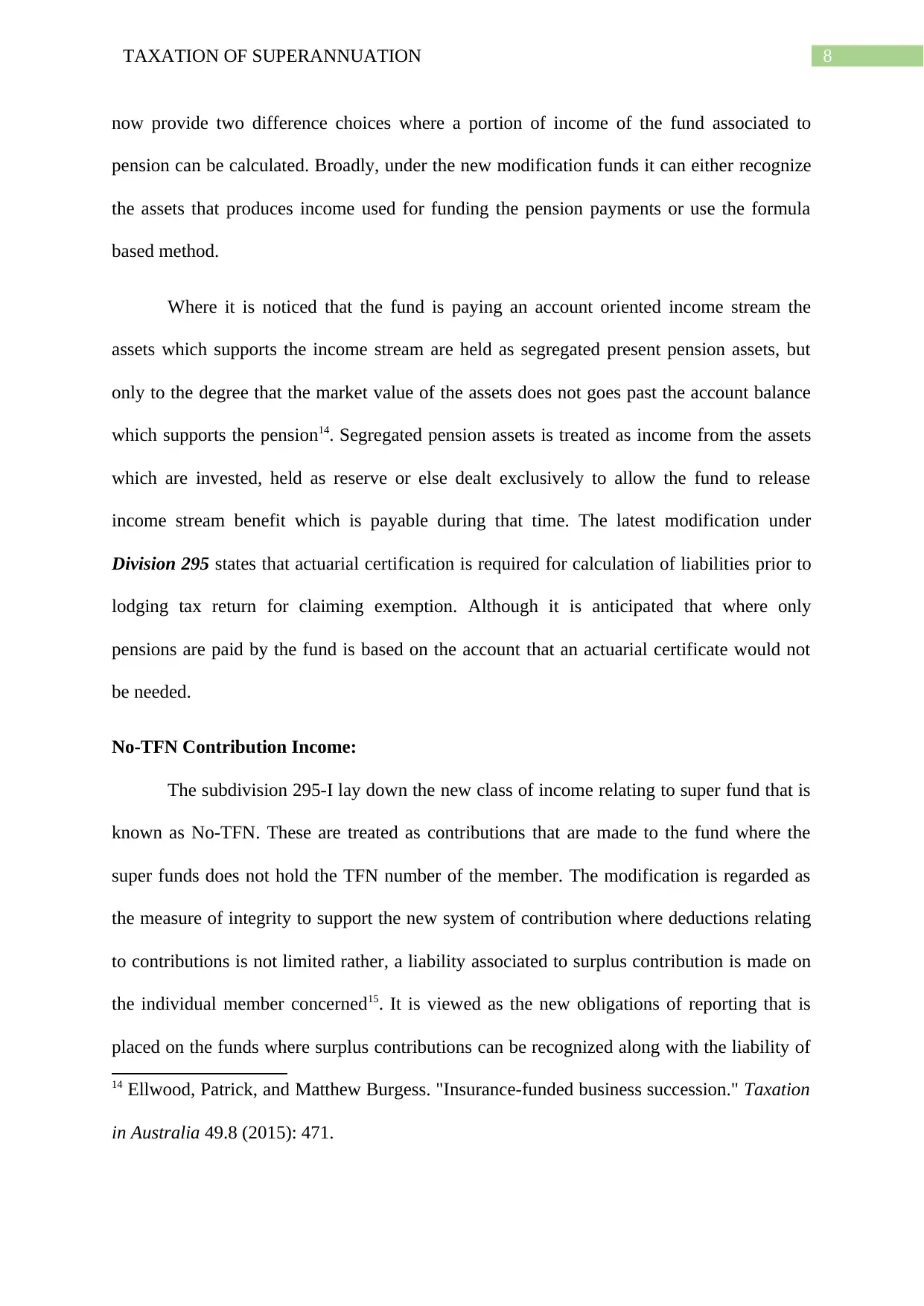
8TAXATION OF SUPERANNUATION
now provide two difference choices where a portion of income of the fund associated to
pension can be calculated. Broadly, under the new modification funds it can either recognize
the assets that produces income used for funding the pension payments or use the formula
based method.
Where it is noticed that the fund is paying an account oriented income stream the
assets which supports the income stream are held as segregated present pension assets, but
only to the degree that the market value of the assets does not goes past the account balance
which supports the pension14. Segregated pension assets is treated as income from the assets
which are invested, held as reserve or else dealt exclusively to allow the fund to release
income stream benefit which is payable during that time. The latest modification under
Division 295 states that actuarial certification is required for calculation of liabilities prior to
lodging tax return for claiming exemption. Although it is anticipated that where only
pensions are paid by the fund is based on the account that an actuarial certificate would not
be needed.
No-TFN Contribution Income:
The subdivision 295-I lay down the new class of income relating to super fund that is
known as No-TFN. These are treated as contributions that are made to the fund where the
super funds does not hold the TFN number of the member. The modification is regarded as
the measure of integrity to support the new system of contribution where deductions relating
to contributions is not limited rather, a liability associated to surplus contribution is made on
the individual member concerned15. It is viewed as the new obligations of reporting that is
placed on the funds where surplus contributions can be recognized along with the liability of
14 Ellwood, Patrick, and Matthew Burgess. "Insurance-funded business succession." Taxation
in Australia 49.8 (2015): 471.
now provide two difference choices where a portion of income of the fund associated to
pension can be calculated. Broadly, under the new modification funds it can either recognize
the assets that produces income used for funding the pension payments or use the formula
based method.
Where it is noticed that the fund is paying an account oriented income stream the
assets which supports the income stream are held as segregated present pension assets, but
only to the degree that the market value of the assets does not goes past the account balance
which supports the pension14. Segregated pension assets is treated as income from the assets
which are invested, held as reserve or else dealt exclusively to allow the fund to release
income stream benefit which is payable during that time. The latest modification under
Division 295 states that actuarial certification is required for calculation of liabilities prior to
lodging tax return for claiming exemption. Although it is anticipated that where only
pensions are paid by the fund is based on the account that an actuarial certificate would not
be needed.
No-TFN Contribution Income:
The subdivision 295-I lay down the new class of income relating to super fund that is
known as No-TFN. These are treated as contributions that are made to the fund where the
super funds does not hold the TFN number of the member. The modification is regarded as
the measure of integrity to support the new system of contribution where deductions relating
to contributions is not limited rather, a liability associated to surplus contribution is made on
the individual member concerned15. It is viewed as the new obligations of reporting that is
placed on the funds where surplus contributions can be recognized along with the liability of
14 Ellwood, Patrick, and Matthew Burgess. "Insurance-funded business succession." Taxation
in Australia 49.8 (2015): 471.
⊘ This is a preview!⊘
Do you want full access?
Subscribe today to unlock all pages.

Trusted by 1+ million students worldwide
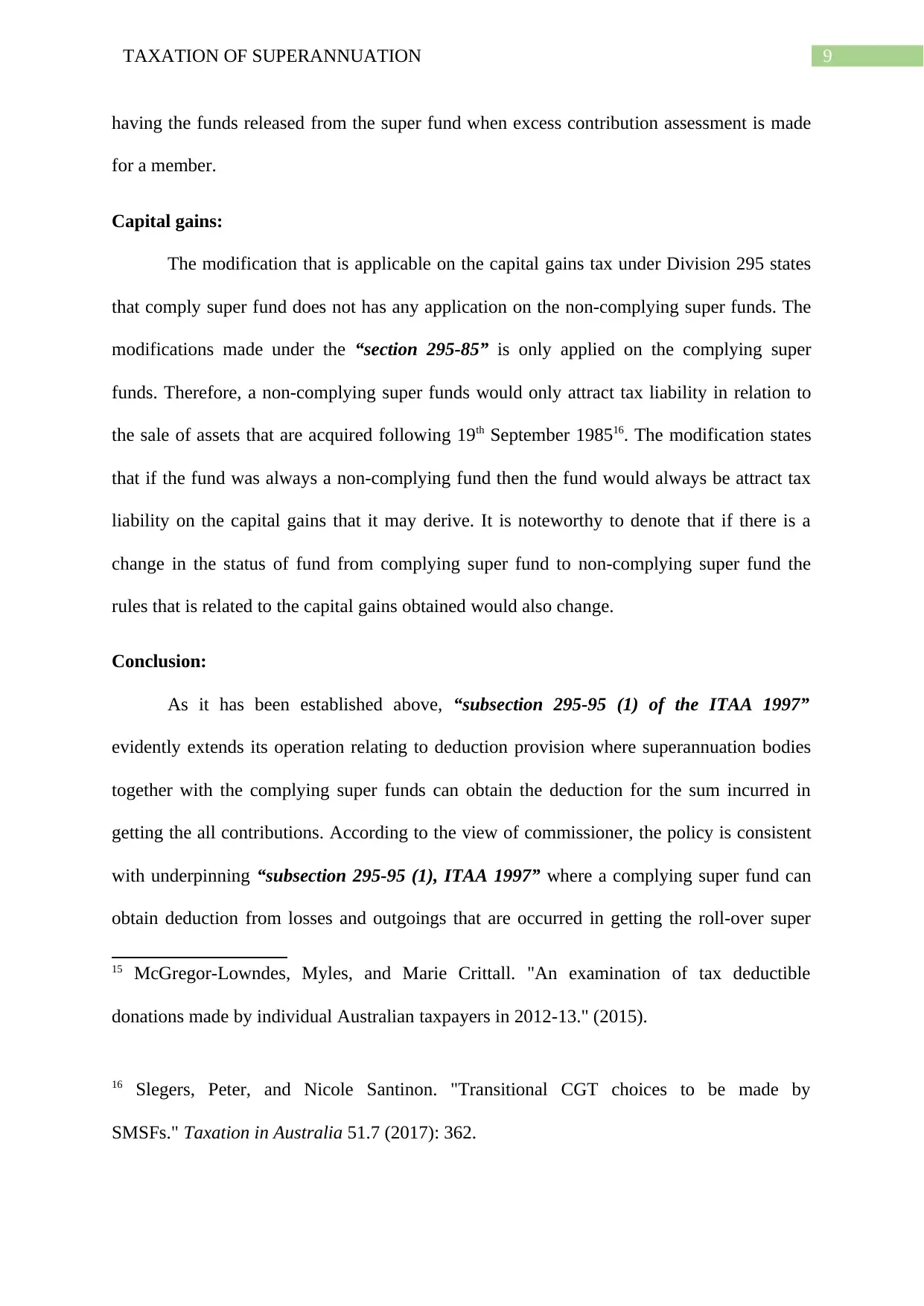
9TAXATION OF SUPERANNUATION
having the funds released from the super fund when excess contribution assessment is made
for a member.
Capital gains:
The modification that is applicable on the capital gains tax under Division 295 states
that comply super fund does not has any application on the non-complying super funds. The
modifications made under the “section 295-85” is only applied on the complying super
funds. Therefore, a non-complying super funds would only attract tax liability in relation to
the sale of assets that are acquired following 19th September 198516. The modification states
that if the fund was always a non-complying fund then the fund would always be attract tax
liability on the capital gains that it may derive. It is noteworthy to denote that if there is a
change in the status of fund from complying super fund to non-complying super fund the
rules that is related to the capital gains obtained would also change.
Conclusion:
As it has been established above, “subsection 295-95 (1) of the ITAA 1997”
evidently extends its operation relating to deduction provision where superannuation bodies
together with the complying super funds can obtain the deduction for the sum incurred in
getting the all contributions. According to the view of commissioner, the policy is consistent
with underpinning “subsection 295-95 (1), ITAA 1997” where a complying super fund can
obtain deduction from losses and outgoings that are occurred in getting the roll-over super
15 McGregor-Lowndes, Myles, and Marie Crittall. "An examination of tax deductible
donations made by individual Australian taxpayers in 2012-13." (2015).
16 Slegers, Peter, and Nicole Santinon. "Transitional CGT choices to be made by
SMSFs." Taxation in Australia 51.7 (2017): 362.
having the funds released from the super fund when excess contribution assessment is made
for a member.
Capital gains:
The modification that is applicable on the capital gains tax under Division 295 states
that comply super fund does not has any application on the non-complying super funds. The
modifications made under the “section 295-85” is only applied on the complying super
funds. Therefore, a non-complying super funds would only attract tax liability in relation to
the sale of assets that are acquired following 19th September 198516. The modification states
that if the fund was always a non-complying fund then the fund would always be attract tax
liability on the capital gains that it may derive. It is noteworthy to denote that if there is a
change in the status of fund from complying super fund to non-complying super fund the
rules that is related to the capital gains obtained would also change.
Conclusion:
As it has been established above, “subsection 295-95 (1) of the ITAA 1997”
evidently extends its operation relating to deduction provision where superannuation bodies
together with the complying super funds can obtain the deduction for the sum incurred in
getting the all contributions. According to the view of commissioner, the policy is consistent
with underpinning “subsection 295-95 (1), ITAA 1997” where a complying super fund can
obtain deduction from losses and outgoings that are occurred in getting the roll-over super
15 McGregor-Lowndes, Myles, and Marie Crittall. "An examination of tax deductible
donations made by individual Australian taxpayers in 2012-13." (2015).
16 Slegers, Peter, and Nicole Santinon. "Transitional CGT choices to be made by
SMSFs." Taxation in Australia 51.7 (2017): 362.
Paraphrase This Document
Need a fresh take? Get an instant paraphrase of this document with our AI Paraphraser
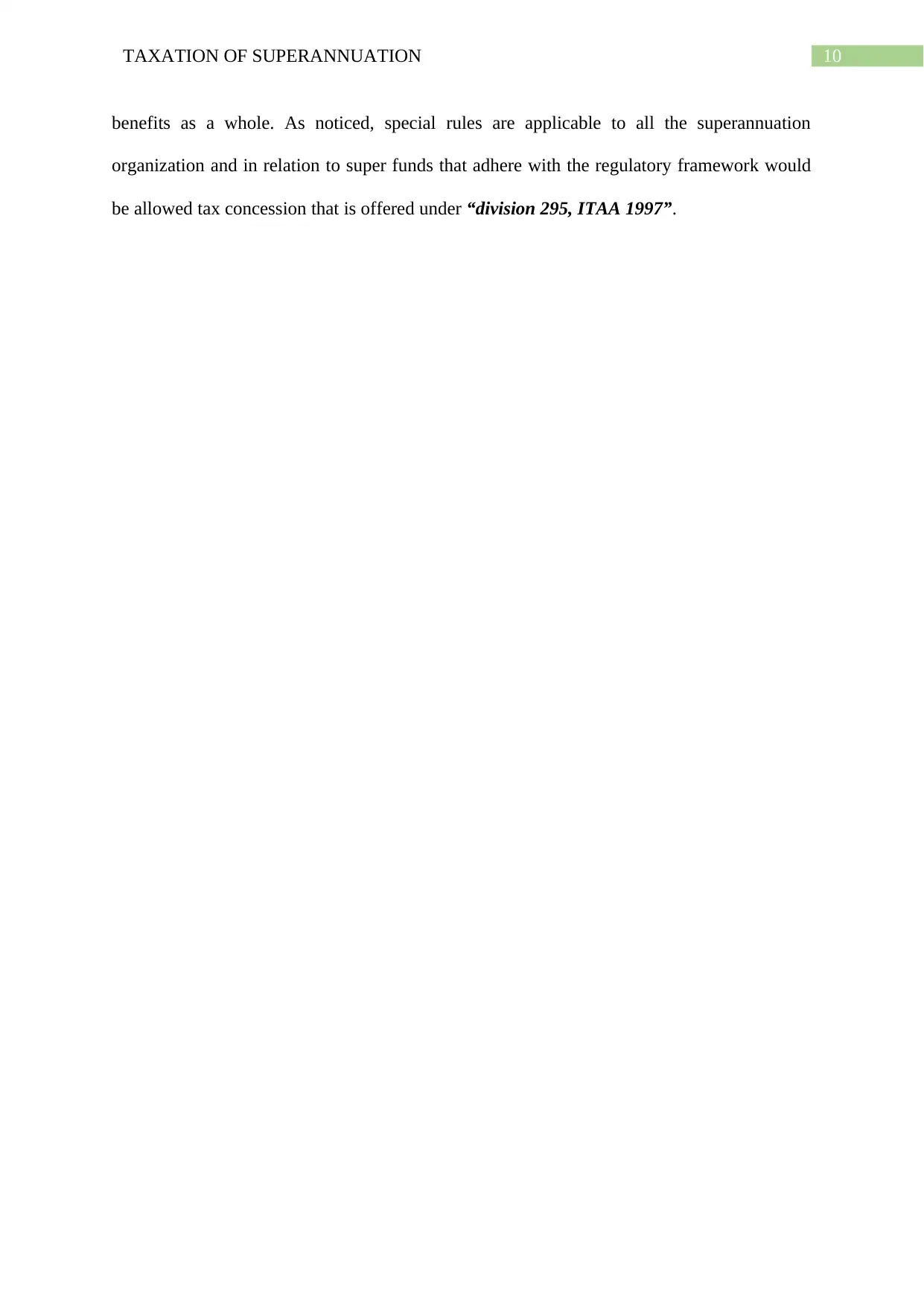
10TAXATION OF SUPERANNUATION
benefits as a whole. As noticed, special rules are applicable to all the superannuation
organization and in relation to super funds that adhere with the regulatory framework would
be allowed tax concession that is offered under “division 295, ITAA 1997”.
benefits as a whole. As noticed, special rules are applicable to all the superannuation
organization and in relation to super funds that adhere with the regulatory framework would
be allowed tax concession that is offered under “division 295, ITAA 1997”.
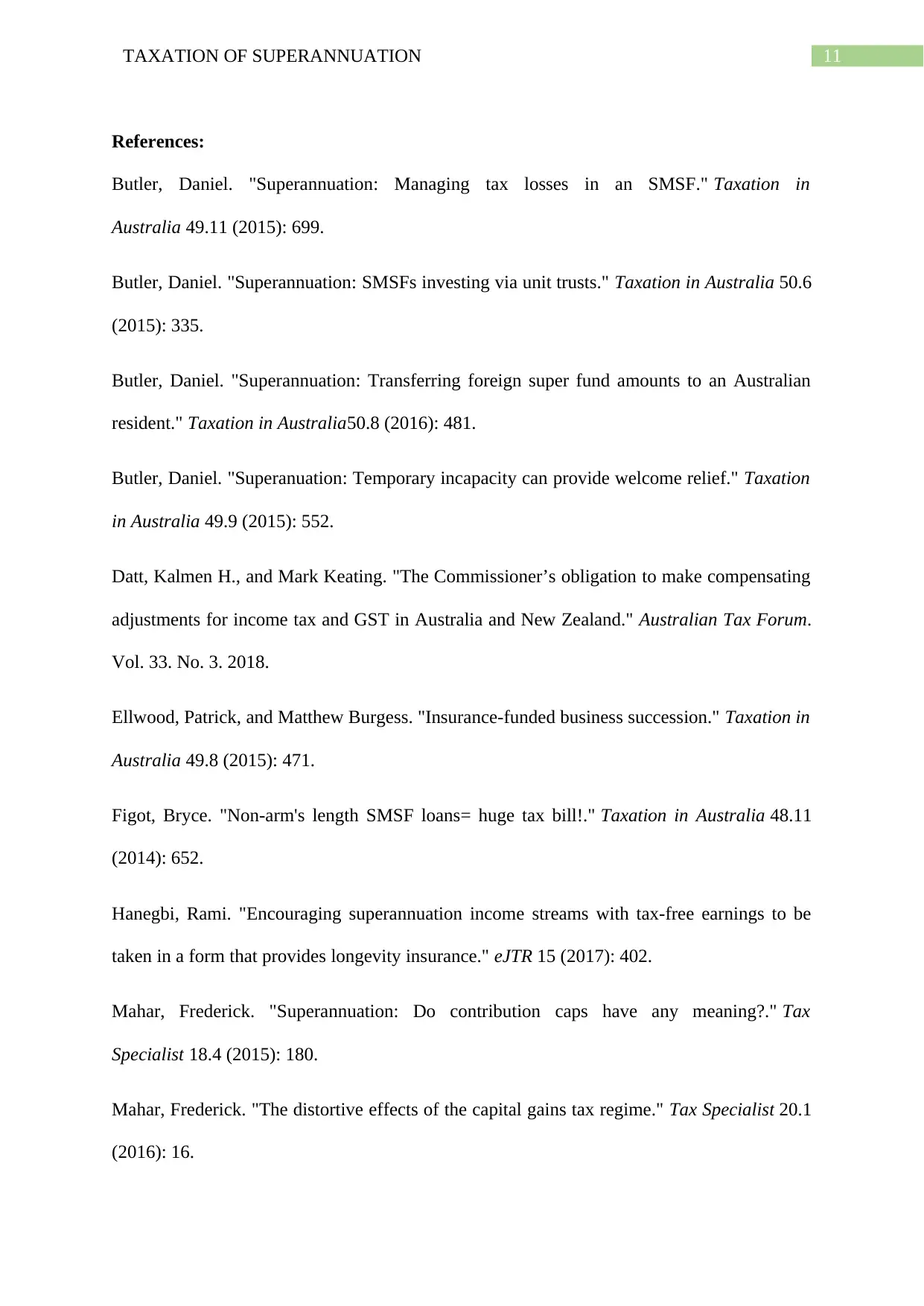
11TAXATION OF SUPERANNUATION
References:
Butler, Daniel. "Superannuation: Managing tax losses in an SMSF." Taxation in
Australia 49.11 (2015): 699.
Butler, Daniel. "Superannuation: SMSFs investing via unit trusts." Taxation in Australia 50.6
(2015): 335.
Butler, Daniel. "Superannuation: Transferring foreign super fund amounts to an Australian
resident." Taxation in Australia50.8 (2016): 481.
Butler, Daniel. "Superanuation: Temporary incapacity can provide welcome relief." Taxation
in Australia 49.9 (2015): 552.
Datt, Kalmen H., and Mark Keating. "The Commissioner’s obligation to make compensating
adjustments for income tax and GST in Australia and New Zealand." Australian Tax Forum.
Vol. 33. No. 3. 2018.
Ellwood, Patrick, and Matthew Burgess. "Insurance-funded business succession." Taxation in
Australia 49.8 (2015): 471.
Figot, Bryce. "Non-arm's length SMSF loans= huge tax bill!." Taxation in Australia 48.11
(2014): 652.
Hanegbi, Rami. "Encouraging superannuation income streams with tax-free earnings to be
taken in a form that provides longevity insurance." eJTR 15 (2017): 402.
Mahar, Frederick. "Superannuation: Do contribution caps have any meaning?." Tax
Specialist 18.4 (2015): 180.
Mahar, Frederick. "The distortive effects of the capital gains tax regime." Tax Specialist 20.1
(2016): 16.
References:
Butler, Daniel. "Superannuation: Managing tax losses in an SMSF." Taxation in
Australia 49.11 (2015): 699.
Butler, Daniel. "Superannuation: SMSFs investing via unit trusts." Taxation in Australia 50.6
(2015): 335.
Butler, Daniel. "Superannuation: Transferring foreign super fund amounts to an Australian
resident." Taxation in Australia50.8 (2016): 481.
Butler, Daniel. "Superanuation: Temporary incapacity can provide welcome relief." Taxation
in Australia 49.9 (2015): 552.
Datt, Kalmen H., and Mark Keating. "The Commissioner’s obligation to make compensating
adjustments for income tax and GST in Australia and New Zealand." Australian Tax Forum.
Vol. 33. No. 3. 2018.
Ellwood, Patrick, and Matthew Burgess. "Insurance-funded business succession." Taxation in
Australia 49.8 (2015): 471.
Figot, Bryce. "Non-arm's length SMSF loans= huge tax bill!." Taxation in Australia 48.11
(2014): 652.
Hanegbi, Rami. "Encouraging superannuation income streams with tax-free earnings to be
taken in a form that provides longevity insurance." eJTR 15 (2017): 402.
Mahar, Frederick. "Superannuation: Do contribution caps have any meaning?." Tax
Specialist 18.4 (2015): 180.
Mahar, Frederick. "The distortive effects of the capital gains tax regime." Tax Specialist 20.1
(2016): 16.
⊘ This is a preview!⊘
Do you want full access?
Subscribe today to unlock all pages.

Trusted by 1+ million students worldwide
1 out of 13
Related Documents
Your All-in-One AI-Powered Toolkit for Academic Success.
+13062052269
info@desklib.com
Available 24*7 on WhatsApp / Email
![[object Object]](/_next/static/media/star-bottom.7253800d.svg)
Unlock your academic potential
Copyright © 2020–2026 A2Z Services. All Rights Reserved. Developed and managed by ZUCOL.





